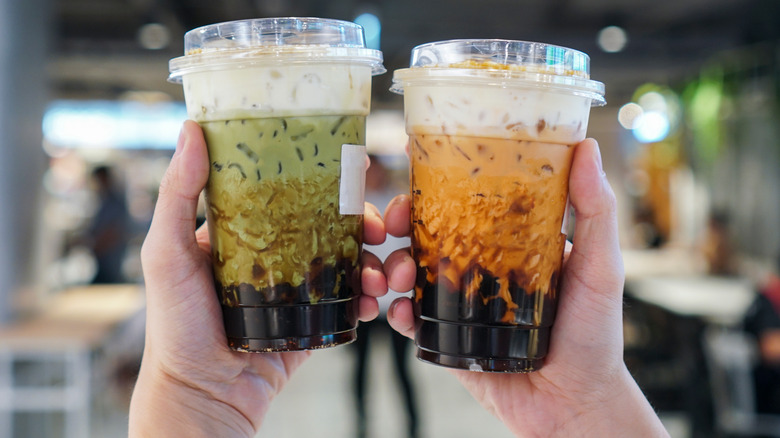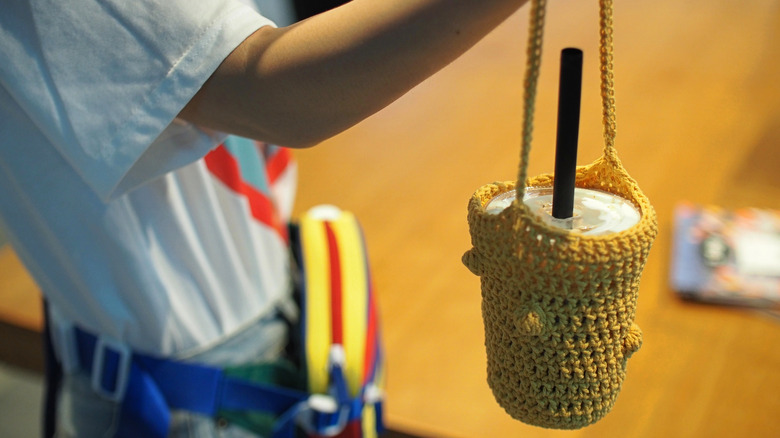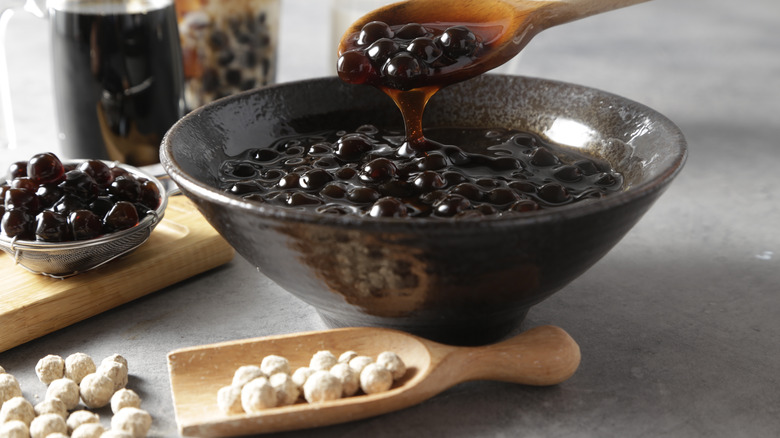Mistakes You Need To Avoid With Bubble Tea
Bubble tea (also known as black pearl tea, boba tea, or just boba) is a popular beverage with many incarnations, from rich and creamy to vibrant and fruity and essentially everything in between. The drink originated in the late 1980s in Taiwan, per Food & Wine, but there are as many hotly contested versions of its origin story as there are variations on bubble tea itself. With options like savory, cheesy, and influencer-ready rainbow available, as explained by Eater, it seems like there's no wrong way to enjoy bubble tea. However, there are a few things you should keep in mind while ordering and preparing it to optimize this unique eating-and-drinking experience.
But first, know that not everyone's on Team Boba. One 2022 article in the medical journal Pediatrics states that the pearls found in boba may pose a choking hazard, and one study points out the drink's potentially problematic sugar content. But if you treat yourself in moderation, your boba habit is unlikely to cause issues. Knowledge is power when it comes to bubble tea, and you're in for an adventure whether you order it out or attempt it at home.
Pay attention to flavor when ordering bubble tea
The first mistake to avoid with bubble tea is not owning at least one custom bubble tea cup holder. With your cup holder in hand, the possibilities are endless. A typical bubble tea menu (like beloved chain Kung Fu Tea's) offers different teas, flavorings, and an array of "toppings" from the popular black tapioca pearls to jelly chunks to caviar-like popping boba and more. Per Eater, typical flavor and topping combos include milky black tea and brown sugar boba and fruit juice with jelly (or passion fruit seeds for crunch). But what if you want to experiment?
Avoid mixing fruity with milky — Gong cha says that the dairy components of bubble tea can be curdled by certain fruits. The add-ins can be on the saccharine side, so The Seattle Times advises choosing a less sweet or unsweetened base tea to avoid an undrinkable disappointment. If you can't have dairy products, be warned: premixed bubble tea powders often contain milk or milk derivatives. Seek out build-your-own boba places with dairy-free options, like Boba Guys.
Temperature is key when making your own bubble tea
So you've declared your undying love of bubble tea and like any self-respecting foodie, you want to make it at home. Classic brown sugar milk tea is as easy as steeping your tea in boiling water — as is making a simple syrup to sweeten the pearls, per the BBC. These can be pre-made or — for a culinary challenge — made from scratch. The pearls themselves typically consist of tapioca flour, sugar, and water, according to Scientific American. But the cooking process is delicate, and a lot can go wrong — especially in the texture department.
In Taiwan, that desirable chewy quality of a perfectly-executed boba pearl is known as "QQ," as Eater notes. When making tapioca pearls at home, Scientific American emphasizes that the mixture of tapioca flour and water must be just right to form those signature squishy balls we love to imbibe/consume. Otherwise, you're liable to end up with neither a liquid nor a solid but a non-Newtonian fluid or "oobleck." Be sure to store boba pearls at room temperature or they'll become hard, and use them within four hours, as they don't keep (per boba suppliers Bossen).
Bubble tea continues to tempt, challenge, and delight its fans — whether homemade or ordered out. With a little guidance and practice, you'll master the art of balancing the signature flavors and textures of this internationally-enjoyed indulgence.


